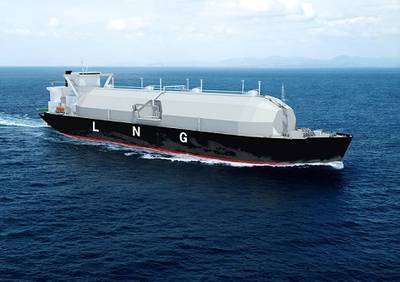MHI : Landmark LNG Carrier Shipbuild Contract
On May 17, 2013, Mitsubishi Heavy Industries Ltd. (MHI) will sign an agreement with Mitsui O.S.K. Lines Ltd. (MOL) to build a Sayaendo series new-generation liquefied natural gas (LNG) carrier. Sayaendo series ships feature a unique structure that integrates the LNG tank cover with the ship hull, resulting in significantly improved fuel consumption and maintainability. From 2020 the new ship will be used mainly for transportation of LNG produced by the Ichthys LNG Project in Australia for Osaka Gas Co., Ltd. and Kyushu Electric Power Co. Inc.
The new LNG carrier will measure 288m in length overall (LOA), 48.94m in width, and 11.55m in draft. The 138,000 gross tonnage (75,000 deadweight tonnage) ship will be capable of carrying up to 153,000 m3 of LNG (cargo tank total volume: 155,000m3) in four Moss-type tanks at a service speed of 19.5 knots per hour. The ship will be built at the MHI Nagasaki Shipyard and Machinery Works.
To protect its four Moss spherical tanks, the Sayaendo features a peapod-shaped continuous cover integrated with the ship's hull in lieu of conventional hemispherical covers. This innovative configuration enables reductions in size and weight while maintaining the ship's overall structural rigidity. The continuous cover over the tanks also improves aerodynamics by substantially reducing air resistance that acts as a drag on ship propulsion. For its main power plant the Sayaendo adopts MHI's "Ultra Steam Turbine Plant" (UST), a new turbine that provides higher thermal efficiency through effective use of thermal energy by reheating steam. Through downsizing, weight reduction and hull line improvement, Sayaendo ships achieve a substantial 20% reduction in fuel consumption compared to conventional ships.
With a conventional cover configuration, pipes, wires and catwalks atop the tanks are supported by complex structures. By covering the tanks with an integrated cover and making those supporting structures unnecessary, the new design also improves maintainability. In addition, CO2 emissions are reduced as a result of decreased fuel consumption, and response to environmental issues is further enhanced with installation of a ballast water treatment system, which addresses impact on the marine ecosystem.
In April of this year MHI and Imabari Shipbuilding Co. Ltd. jointly established MI LNG Company Ltd., to handle the design and marketing of LNG carriers. Although this joint venture company handles LNG carrier orders, negotiations for the current Sayaendo LNG carrier predate the establishment of MI LNG, therefore it was directly contracted with MHI.
After receiving an order for two ships in October 2011, to date MHI has received orders for six Sayaendo series carriers in total, including the current order. The Sayaendo has been drawing great attention in the marine transport industry and is quickly becoming a leading force in the movement to develop energy-saving "eco-ships" offering enhanced environmental performance - an area in which the Japanese shipbuilding industry is actively engaged.
Owing to the suspended operation of nuclear power plants in Japan in the wake of the Great East Japan Earthquake, as well as a expanded shale gas production in the U.S., demand for LNG and LNG carriers has been expanding not only in Japan but globally. As such, MHI will continue to expand its efforts to secure new orders for Sayaendo and other types of LNG carriers.
www.mhi.co.jp














